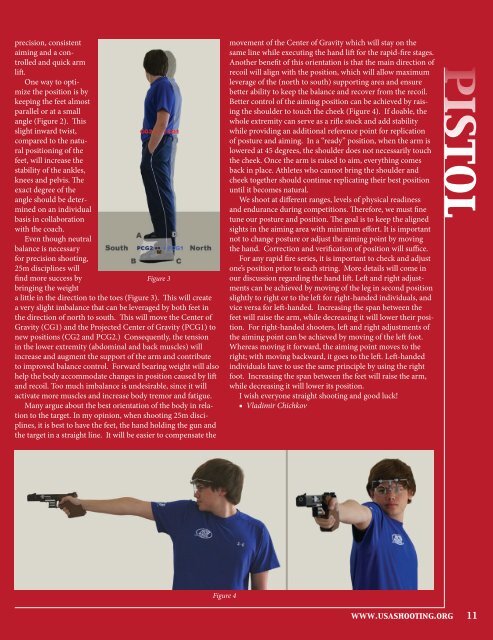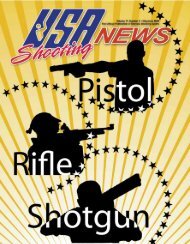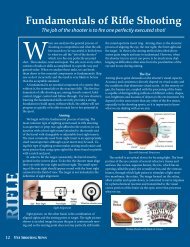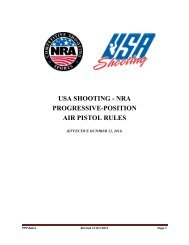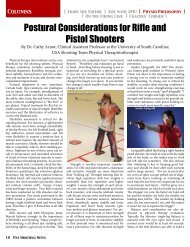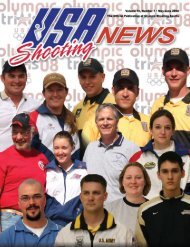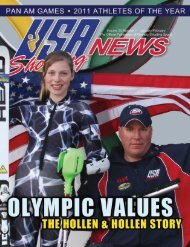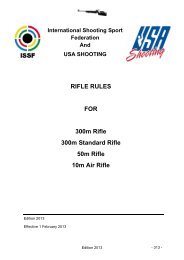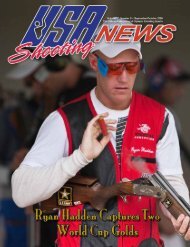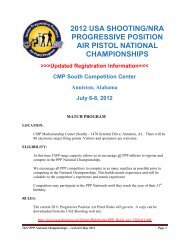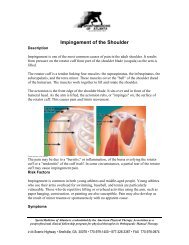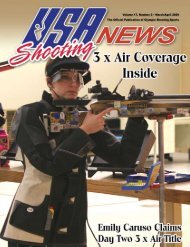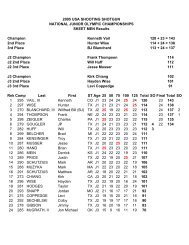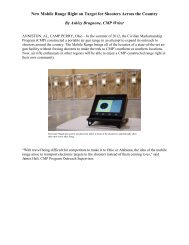November/December 2010: Volume 18, Number 6 - USA Shooting
November/December 2010: Volume 18, Number 6 - USA Shooting
November/December 2010: Volume 18, Number 6 - USA Shooting
- No tags were found...
Create successful ePaper yourself
Turn your PDF publications into a flip-book with our unique Google optimized e-Paper software.
precision, consistentaiming and a controlledand quick armlift.One way to optimizethe position is bykeeping the feet almostparallel or at a smallangle (Figure 2). Thisslight inward twist,compared to the naturalpositioning of thefeet, will increase thestability of the ankles,knees and pelvis. Theexact degree of theangle should be determinedon an individualbasis in collaborationwith the coach.Even though neutralbalance is necessaryfor precision shooting,25m disciplines willfind more success byFigure 3bringing the weighta little in the direction to the toes (Figure 3). This will createa very slight imbalance that can be leveraged by both feet inthe direction of north to south. This will move the Center ofGravity (CG1) and the Projected Center of Gravity (PCG1) tonew positions (CG2 and PCG2.) Consequently, the tensionin the lower extremity (abdominal and back muscles) willincrease and augment the support of the arm and contributeto improved balance control. Forward bearing weight will alsohelp the body accommodate changes in position caused by liftand recoil. Too much imbalance is undesirable, since it willactivate more muscles and increase body tremor and fatigue.Many argue about the best orientation of the body in relationto the target. In my opinion, when shooting 25m disciplines,it is best to have the feet, the hand holding the gun andthe target in a straight line. It will be easier to compensate themovement of the Center of Gravity which will stay on thesame line while executing the hand lift for the rapid-fire stages.Another benefit of this orientation is that the main direction ofrecoil will align with the position, which will allow maximumleverage of the (north to south) supporting area and ensurebetter ability to keep the balance and recover from the recoil.Better control of the aiming position can be achieved by raisingthe shoulder to touch the cheek (Figure 4). If doable, thewhole extremity can serve as a rifle stock and add stabilitywhile providing an additional reference point for replicationof posture and aiming. In a “ready” position, when the arm islowered at 45 degrees, the shoulder does not necessarily touchthe cheek. Once the arm is raised to aim, everything comesback in place. Athletes who cannot bring the shoulder andcheek together should continue replicating their best positionuntil it becomes natural.We shoot at different ranges, levels of physical readinessand endurance during competitions. Therefore, we must finetune our posture and position. The goal is to keep the alignedsights in the aiming area with minimum effort. It is importantnot to change posture or adjust the aiming point by movingthe hand. Correction and verification of position will suffice.For any rapid fire series, it is important to check and adjustone’s position prior to each string. More details will come inour discussion regarding the hand lift. Left and right adjustmentscan be achieved by moving of the leg in second positionslightly to right or to the left for right-handed individuals, andvice versa for left-handed. Increasing the span between thefeet will raise the arm, while decreasing it will lower their position.For right-handed shooters, left and right adjustments ofthe aiming point can be achieved by moving of the left foot.Whereas moving it forward, the aiming point moves to theright; with moving backward, it goes to the left. Left-handedindividuals have to use the same principle by using the rightfoot. Increasing the span between the feet will raise the arm,while decreasing it will lower its position.I wish everyone straight shooting and good luck!■ Vladimir ChichkovpistolFigure 4www.usashooting.org 11Nov-Dec Issue <strong>2010</strong>.indd 1111/8/10 9:22 PM


